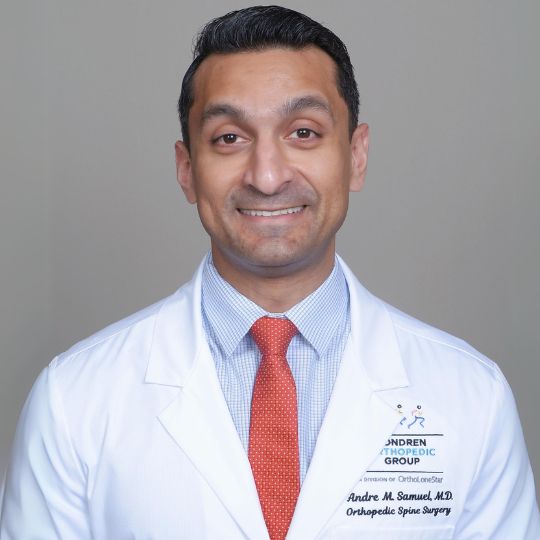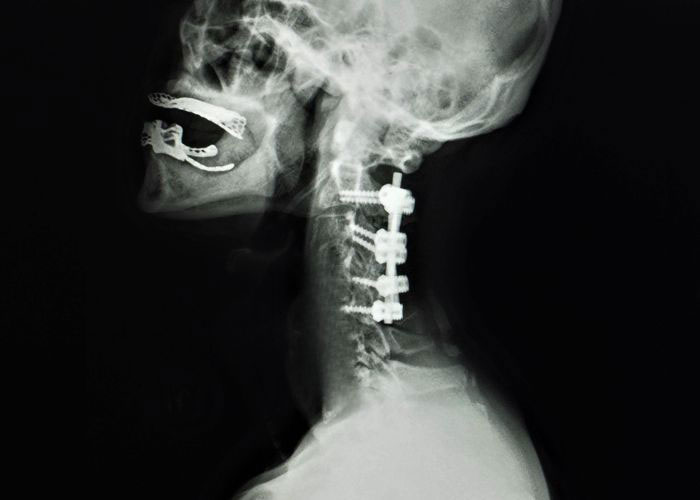Posterior Cervical Decompression and Fusion Surgeon
Do you have serious neck issues that compress the spinal cord or nearby nerves? Posterior cervical decompression and fusion is ideal for patients with constant pain, numbness, or weakness in an arm or hand and is recommended after conservative treatments fail. Doctor Andre M. Samuel, orthopedic spine surgeon, treats patients in the Clear Lake, Houston, Sugar Land, TX area who could benefit from a posterior cervical decompression and fusion. Contact Dr. Samuel’s team today!

What is posterior cervical decompression and fusion?
Posterior cervical decompression and fusion (PCDF) relieves pressure on the spinal cord and stabilizes the neck. The procedure can be performed from the front (anterior) or the back (posterior) of your neck. With PCDF, the surgeon enters from the back, removes what’s pressing on the nerves, and then uses hardware to help fuse the vertebrae. Doctor Andre M. Samuel, orthopedic spine surgeon, treats patients in the Clear Lake, Houston, Sugar Land, TX area who may need posterior cervical decompression and fusion.

What makes the posterior approach more effective?
The posterior approach is effective for treating conditions that impact multiple cervical spine levels or when compression occurs near the back of the cervical spine.
One of the key advantages is less disruption of the surrounding tissues and muscles, leading to less postoperative pain and shorter recovery times. It also provides Dr. Samuel with better visibility of the spinal cord and nerve roots, making it easier for him to decompress affected areas without causing unnecessary trauma to other structures.
Who is a candidate for posterior cervical decompression and fusion?
Posterior cervical decompression and fusion is one option for those dealing with serious neck issues that compress the spinal cord or nearby nerves. It’s ideal for patients with constant pain, numbness, or weakness in an arm or hand and is recommended after conservative treatments fail.
The procedure is also used to treat conditions like cervical spinal stenosis, where the spinal canal narrows and leads to arm pain and coordination issues. It also works well for those with cervical disc herniations, traumatic injuries, or even tumors or infections that cause spine instability. It’s important to be evaluated by an expert spine surgeon like Dr. Samuel to determine if surgery is the right option.
How is posterior cervical decompression and fusion (PCDF) performed?
The patient is put to sleep under general anesthesia before the posterior cervical decompression and fusion. Dr. Samuel then makes an incision at the back of the neck to access the affected area. He removes any bone spurs, disc material, or other tissues pressing on the spinal cord or nerve roots. This is the “decompression” part, to alleviate pain.
Once the pressure is relieved, Dr. Samuel moves on to the “fusion” part. He uses a combination of bone grafts, screws, and plates to fuse the affected vertebrae. Over time, the bone grafts will fuse with your natural bone, creating a strong, stable spine section. Once everything is back in place, the incision is closed.
How long does it take to recover from posterior cervical decompression and fusion?
Recovering from posterior cervical decompression and fusion varies from person to person, but usually takes a few months. The patient may spend a day or two in the hospital following surgery. Once home, gentle movements are encouraged and physical therapy may begin. Most people can return to light activities or work within 4 to 6 weeks. A full recovery, including bone fusion, can take 3 to 6 months. Following all of Dr. Samuel’s post-surgical instructions ensures a successful outcome.



